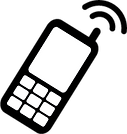FROM SMOKE SIGNALS TO WIRELESS RADIO
The history of wireless communication goes as far back as we can look into modern human history. For thousands of years people have been inventing ways of communicating over long distances using all kinds of techniques ranging from fireworks to carrier pigeons! The early forms of wireless telegraphic systems actually did use things such as fireworks, and smoke or light signals to transmit information in the form of a string of encoded symbols. All of this off course looks hopelessly primitive compared to what the smart phone sitting in our pockets can do today. But as you will soon see, the DNA of that very phone were manufactured in this early era.
The Photophone
A fascinating invention in the early days of wireless telephony was the Photophone created by Alexander Graham Bell and his assistant Charles Sumner Tainter in February 1880.

Figure 1: Technical Drawing of the Photophone appearing in Alexander Graham Bell and Sumner Tainter’s USA patent 235496 titled “Photo phone-transmitter” published on 14 December 1880. (Pre-1923 work. Public domain. Not under copyright.)
The Photophone was remarkably elegant in its simplicity.
A beam of light was focused into a parabolic mirror which reflected the light right out. One spoke into the back side of such a mirror. The mirror flexed back and forth ever so slightly in response to the varying pressure of the sound waves hitting it on its back side. This flexing of the mirror’s surface caused the light that was being reflected by the mirror to be proportionately modulated, i.e. its frequency was altered in proportion to the amount and frequency of the flexing of its surface. Thus the light waves that were reflected out from the mirror effectively encoded the speech of the person who was speaking into the backside of the mirror!
The receiver consisted of another parabolic mirror which focused the received light waves into a special material known as transducer which converted light back into sound. Alexander Graham Bell used Lampblack as the trans-ducting material in his original design.

Figure 2: Left: Alexander Graham Bell (1847-1922). Right: Charles Sumner Tainter (1854-1940)
(Public domain. Pre-1923 photographs. Copyrights expired.)
Bell was enormously proud of the Photophone, proclaiming it to be his greatest invention, and also wanting to name his second daughter “Photophone”! Mrs. Bell is said to have wisely discouraged her husband from taking this step.
Bell’s Photophone was subsequently enhanced by himself as well as several other adopters of the device in many important ways. The direct sound-to-light coupling of the original device was changed into a sound-to-electrical-to-light coupling. The range of the Photophone was increased to several miles. The light source was changed from sunlight to a variety of artificial light sources including infrared light.
The Photophone was also adopted in battlefields during the 1930s and 1940s for communicating between battlefield field units. A very useful advantage that the Photophone enjoyed in the battlefield was that its light based transmission mechanism could not be easily eavesdropped upon.
By the turn of the 19th century the advent of radio telegraphy and radio telephony, with their much longer range and the high degrees of reliability they offered under adverse weather conditions proved to be the beginning of the end for the Photophone as a practical wireless communication system.
The Photophone proved to be a lens into the future of communication in a number of ways. For example, the principles of sound-to-electricity-to-light and vice-versa conversion used by the Photophone were astoundingly similar to the fiber-optic based communication systems that came into use almost a century after the Photophone’s invention in 1880.
The advent of radio communication
While Alexander Bell’s Photophone in the 1880s provided a magnificent portal into the future of optical communication, a revolution of an entirely different kind was brewing in Europe and in the United States in the area of radio frequency communications.
Radio waves are the portion of the electromagnetic spectrum between 3 Kilo Hertz and 300 Giga Hertz. The corresponding wavelengths range from 100 Kilometers down to 1 millimeter. Their use as the medium for sending telegraphic messages proved to be a significant up-shift in what was possible in the field of long distance wireless communication.
In fact the genesis of radio as a method of communication goes all the way back to the early 1800s.
